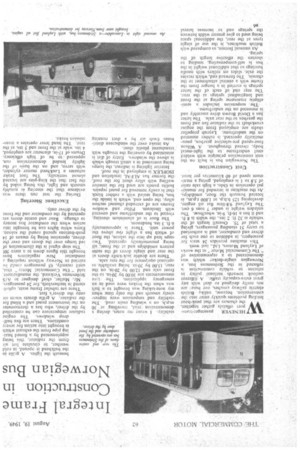Integral Frame Construction in Norwegian Bus
Page 40

If you've noticed an error in this article please click here to report it so we can fix it.
WHENEVER passenger-..trallsport officials gather together. T.V the chances are that peak-hour loading problems"quiekly enter into the conversation, because, unlike British electric railway coaches, our huszo are not really designed. 40 deal with any great extra-capacity traffic. A different outlook towards • .natiOnat paticY in relation to vehicle construction is reflected in the StrOmrnens bus, a Norwegian single-decker which was demonstrated to a representative of "The Commercial Motor" at the works of Leyland Motors, Ltd., last week. This machine provides 24 seats for passengers, in addition to one each for driver and Conductor, and is authorized to carry 51 standing passengers, giving a total of 75. Overall length of the vehicle is 32 ft. 2 ins., the width is 8 ft. and it has a 16-ft. 9-in, wheelbase. The unladen weight is under 7 tons 6 cwt. The Leyland 9.8-1itre flat oil engine, developing 125 b.h.p. at 1,800 r.p.m., iS located beneath the floor, amidships. As the machine is intended for municipal operation in Oslo. a high axle ratio of 5.8 to 1 is employed, giving a maximum speed of 60 kilometres per hour.
Unit Construction
The Norwegian bus is built ors the unit construction principle with welded steel unclerframe to the light-metal body, riveted throughout. A Wilson four-speed pre-selective gearbox, pneumatically operated, is rubber mounted on the underframe. Layrub propeller shafts are employed from the engine crankshaft to the radiator fan and from the gearbox to the rear axle. The latter has a David Brown drive assembly and is Mounted on the underframe.
-The . suspension includes a semielliptic transverse spring at the front and longitudinal springs atthe rear. The rear end of each of the latter springs is carried in a hanger from the franie with a central attachment to the chassis. The forward end, which retains the a-xle, slides on rollers with needle bearings so that additional weight in the bus is self-compensating, tending to shorten the effective length of the spring.
An unusual feature, as compared with British machines, is the use of single tyres at the rear, the additional space being used to give greater width between the springs and to increase. lateral stability. I wrote my notes, during a. demonstration trial, travelling at 30 m.p.h. on a winding main road. The
• stability and suspension were impressively smooth and the only time when my note-taking was brought to a halt was when the brakes were used in an emergency application. The Lyre measurements are 10.00 by 201-in. to Use front axle and 12.00 by 20-in, on the rear, 13.00 by 20-in, being available, as optional equipment for the rear axle.
There are double jack-knife doors at the rear and single doors of the same pattern amidships and at the front; all being pneumatically operated. Two steps lead up into the saloon, the floor of which has a slight rise above the power unit. There is approximately 6 ft. 3 ins. headroom.
The floor is of aluminium sheeting, riveted to the underftame and covered with linoleum. Pillar and window frames are of extruded channel section alloy, the open end, which is inside the bus, being sealed with a rubber block that is easily removed for panel repairs. lsofite panels are used for the interior walling with alloy sheet for the roof, the former has ALFAL insulation and TSOFLEX is employed in the roof.
Interior lighting is indirect, the lamps being contained in a small trough which is. above the windows. Entry of dirt is minimized by covering the troughs with translucent plastic sheet.
An intake over the windscreen distributes fresh air by a duct running
beneath the lights. A grille in the bulkhead is opened, in cold weather, to circulate hot air from the radiator, this being supplemented by a finned heat. ing pipe from the exhaust which is brought into action for severe conditions. There are five halfdrop windows. The engine radiator temperature can be controlled by the driver, who has a thermometer on the instrument panel and a blind for the radiator. A grille directs warm air onto the driver's feet.
There are tubular frame seats, upholstered in leatherclotb, for 24 passengers.
Mr. Muller, chief designer to AtS Striimmens .Verksted, the manufacturer, told 'The Commercial Motor" that, until recently, 65 passengers could he carried in Norway without requiring a conductor New regulations have brought this figure ,down to a Mere 50!
The stop signal is the illumination of red lamps over the doors and over the driver, operation being by means of 14 push-buttons spaced round the saloon. Extra while lights can be brought into action when the conductor has money to change. Rear and centre doors are operated by the conductor and the front by the driver only.
Excellent Steering
During the test run there was evidence that the steering is notably smoOth and light, this being aided by the fact that the king-pins are located almost vertically. The foot brake actuates a Lockheed master cylinder, with servo, and on the bask or the lightly loaded demonstration run, appeared to be of • high efficiency. Drums of 17-in, diameter are employed, 4 ins, wide at the front and 5 inS, at the rear. The hand lever operates a transmission brake.




















































































